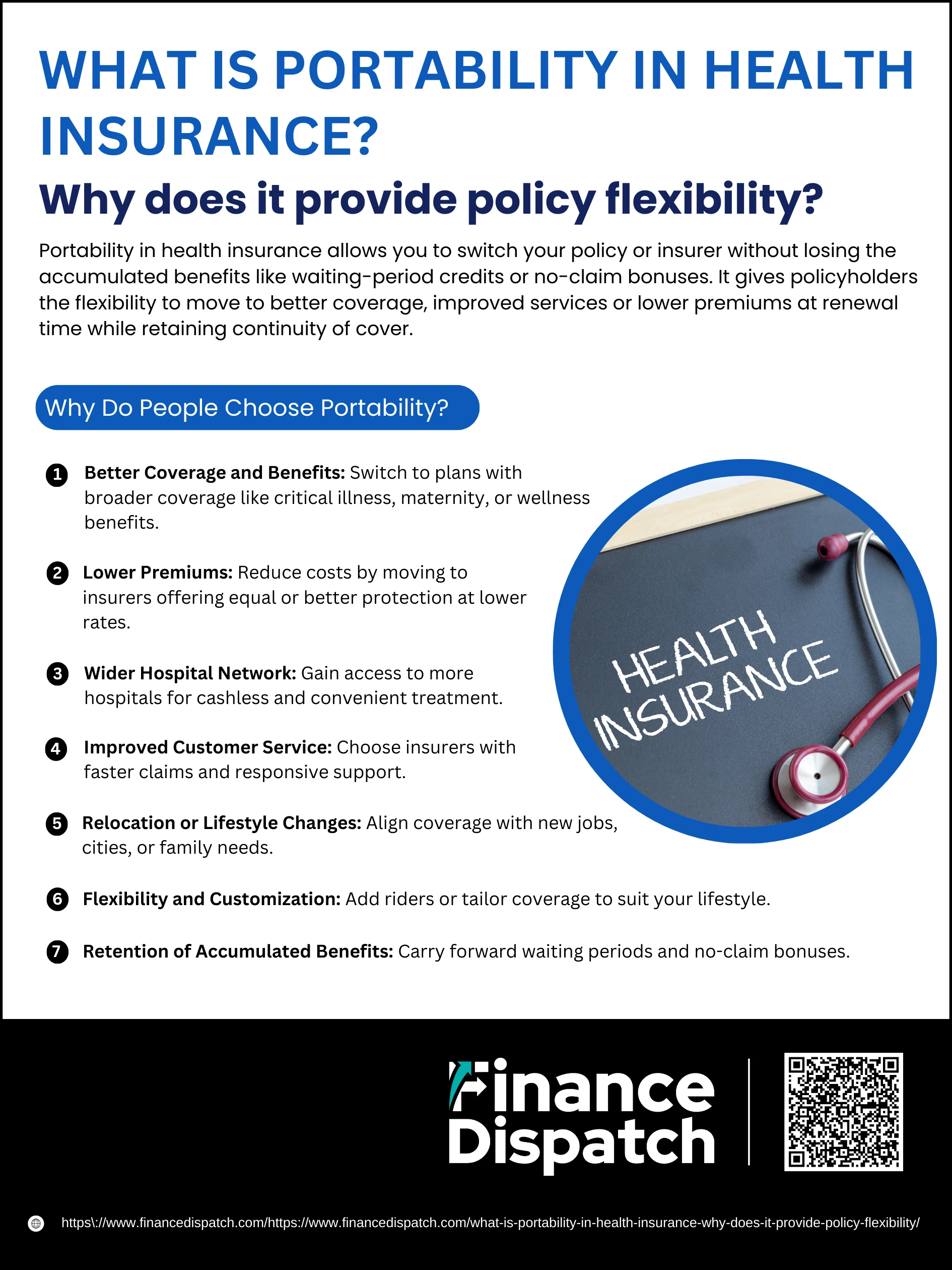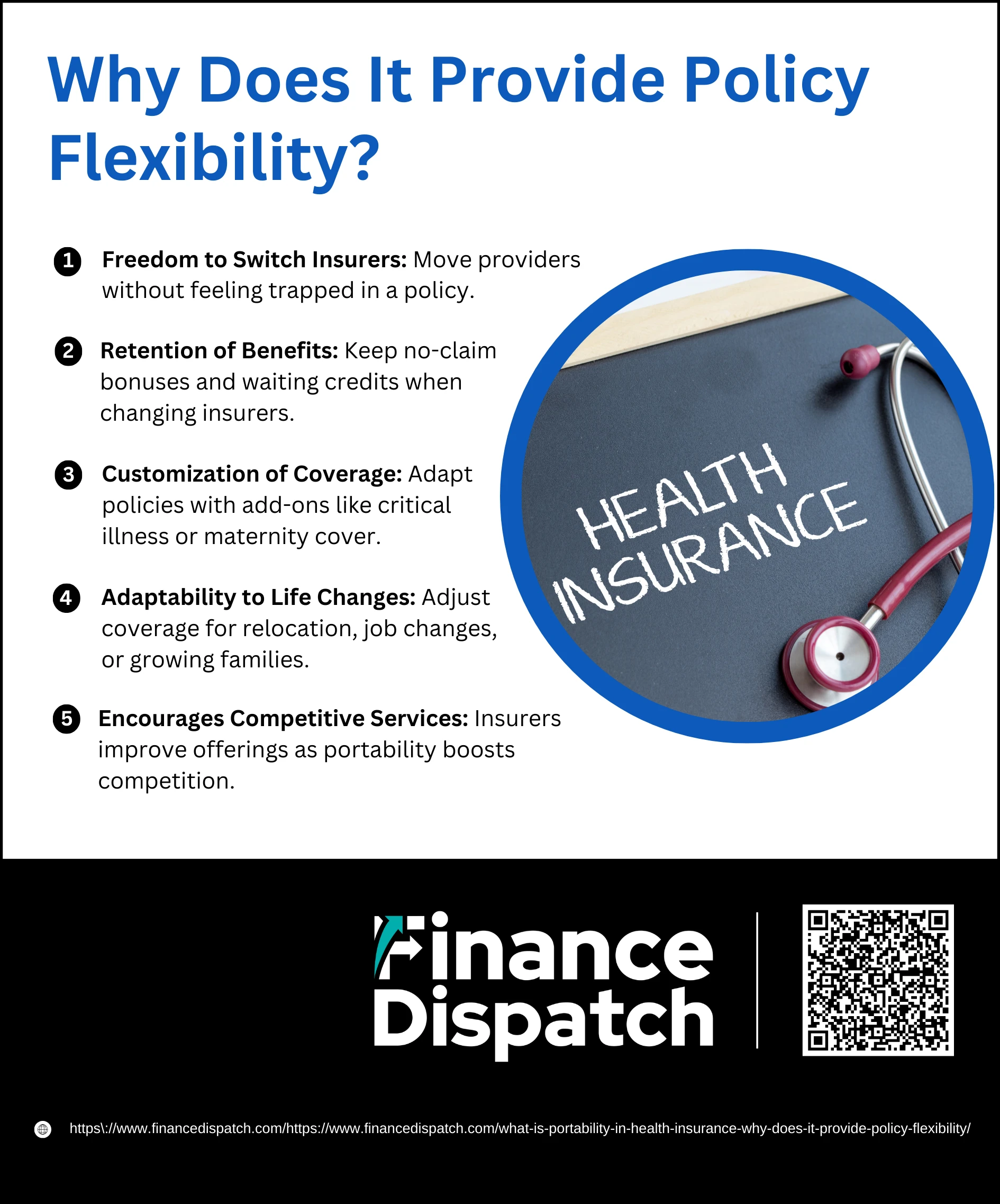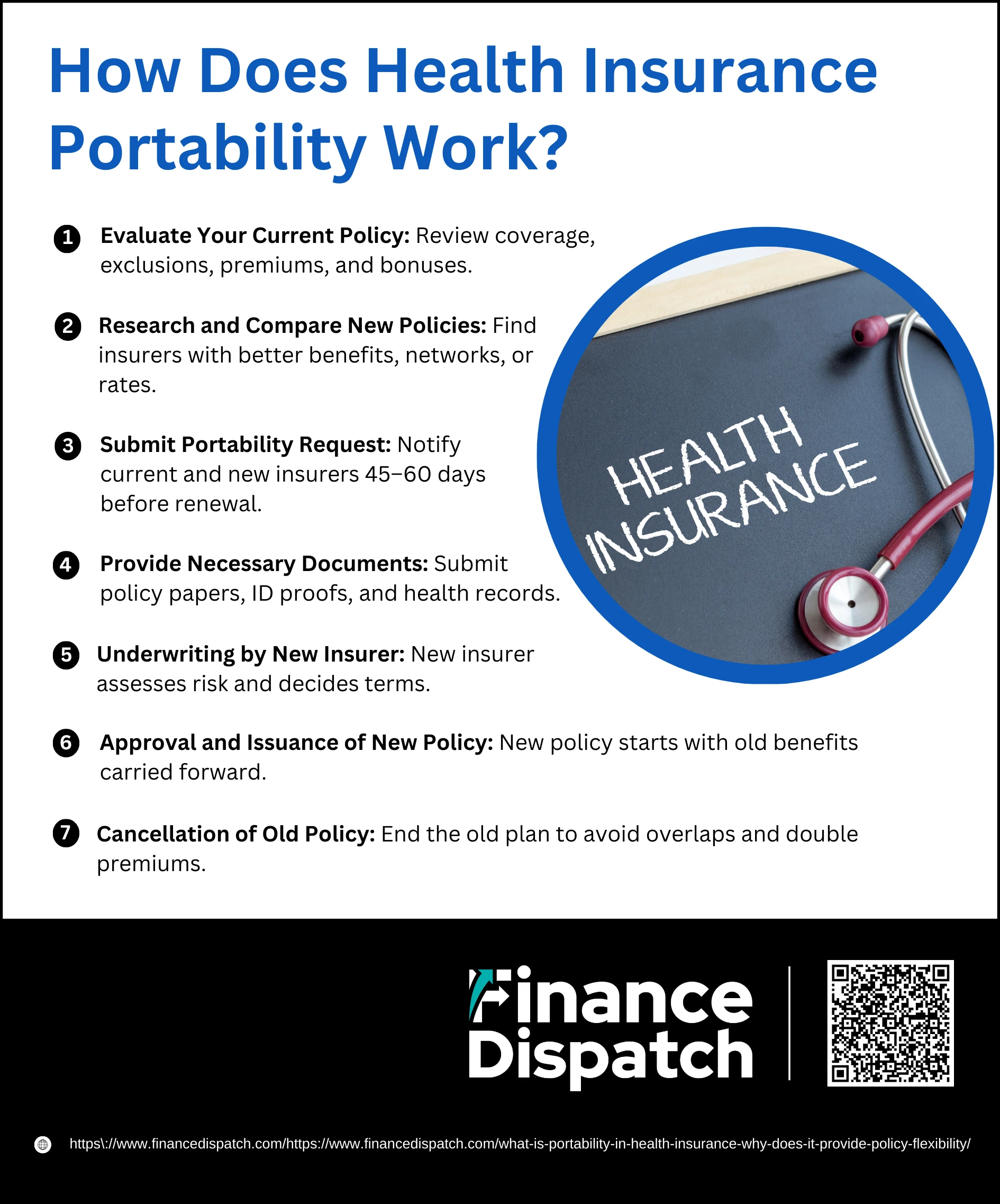In today’s fast-changing healthcare landscape, you don’t want to feel locked into a health insurance plan that no longer fits your needs. Rising medical costs, relocation, job changes, or even dissatisfaction with customer service can make you rethink your coverage. This is where portability in health insurance comes into play. It gives you the freedom to switch from one insurer to another without losing the benefits you’ve already earned, such as waiting period credits or no-claim bonuses. By ensuring continuity while allowing you to customize coverage, compare better options, and adapt to life’s changes, portability provides the kind of policy flexibility that empowers you—not the insurer—to stay in control of your health and financial security.
What is Health Insurance Portability?
Health insurance portability is the option that allows you to transfer your existing health insurance policy from one insurer to another—or even switch plans within the same insurer—without losing the benefits you’ve already accumulated. This means that waiting periods already served, coverage for pre-existing conditions, or rewards like no-claim bonuses are carried forward to the new plan. In simple terms, portability ensures that you don’t have to start over when you change insurers, giving you the confidence that your healthcare protection continues seamlessly while you explore policies that better match your changing needs.
 Why Do People Choose Portability?
Why Do People Choose Portability?
People often discover that their health insurance policy isn’t keeping up with their needs, whether it’s due to rising costs, limited hospital options, or poor service. Portability gives them a way out, offering better coverage and flexibility without having to give up the benefits they’ve already earned. Here’s a closer look at the most common reasons policyholders choose to port their health insurance:
1. Better Coverage and Benefits
Over time, healthcare needs evolve. Another insurer may offer broader coverage for critical illnesses, outpatient care, wellness programs, or maternity benefits that your current plan lacks. By porting, you can gain access to these features and ensure your policy grows with your lifestyle.
2. Lower Premiums
Affordability is one of the strongest drivers of portability. If your current premiums have risen sharply or feel too expensive for the coverage provided, switching to a new insurer can help you secure the same or even better protection at a lower cost, easing the strain on your budget.
3. Wider Hospital Network
Having access to a large network of hospitals is crucial for cashless treatment and convenience. If your existing insurer has a limited or less relevant hospital network, porting allows you to switch to an insurer with better connections—ensuring you receive care where and when you need it.
4. Improved Customer Service
Delays in claim settlement, unresponsive customer support, or complicated procedures often leave policyholders dissatisfied. Portability gives you the opportunity to move to an insurer known for smoother claim processes, quick assistance, and better grievance handling.
5. Relocation or Lifestyle Changes\
Life changes such as moving to a new city, changing jobs, or starting a family may require a policy that’s more aligned with your current circumstances. Porting ensures that your coverage continues seamlessly while adapting to these new needs without disruption.
6. Flexibility and Customization
Not all policies offer the freedom to add riders or tailor coverage. Through portability, you can choose an insurer that allows customization—whether it’s adding coverage for specific illnesses, increasing your sum insured, or selecting family-centric features.
7. Retention of Accumulated Benefits
Perhaps the biggest advantage of portability is that you don’t lose what you’ve already built up. Waiting periods for pre-existing conditions and no-claim bonuses are carried forward, so you don’t have to restart the clock just because you’ve switched insurers.
 Why Does It Provide Policy Flexibility?
Why Does It Provide Policy Flexibility?
The real strength of health insurance portability lies in the flexibility it provides. Instead of being stuck with one insurer or a rigid plan, you can adapt your coverage as your health, financial situation, or life circumstances change. This ensures your policy always works for you, not the other way around. Here’s how portability creates policy flexibility:
1. Freedom to Switch Insurers
Portability gives you the option to move to another insurer if you’re not satisfied with your current provider’s premiums, claim settlement ratio, or hospital network. This freedom eliminates the feeling of being “trapped” in a policy and ensures you always have the ability to choose a company that better meets your expectations.
2. Retention of Benefits
One of the biggest concerns when switching policies is losing hard-earned advantages like no-claim bonuses or completed waiting periods for pre-existing illnesses. With portability, these benefits are carried forward seamlessly. This means you can switch providers without the fear of starting over, which makes policy changes a practical and flexible option.
3. Customization of Coverage
Every individual’s healthcare needs are unique and often change over time. Through portability, you can choose insurers that allow you to tailor coverage with add-ons or riders—like maternity cover, critical illness protection, or wellness benefits. This flexibility ensures that your policy grows with your changing lifestyle and medical requirements.
4. Adaptability to Life Changes
Relocation to a new city, a job switch, or even an expanding family may demand different healthcare coverage. Portability helps you adjust your policy to align with these changes, such as increasing the sum insured, expanding network hospital access, or adding family members, all while maintaining continuity of coverage.
5. Encourages Competitive Services
Because policyholders can port their policies, insurers are pushed to improve their offerings. This competitive pressure often results in better claim settlement processes, wider hospital networks, and customer-friendly features. For policyholders, this translates into greater flexibility to demand and receive better service.
 How Does Health Insurance Portability Work?
How Does Health Insurance Portability Work?
Porting a health insurance policy is more than just switching providers—it’s a structured process that ensures you don’t lose your accumulated benefits while moving to a plan that better fits your needs. Here’s how the process works step by step:
1. Evaluate Your Current Policy
The first step is to understand where you stand with your existing plan. Review your coverage limits, exclusions, premium amounts, and any waiting periods that have already been served. Also, check benefits like no-claim bonuses or wellness perks. This evaluation helps you identify what you want to carry forward and what improvements you expect in your new policy.
2. Research and Compare New Policies
Once you know your requirements, explore plans from other insurers. Look for options with wider hospital networks, lower premiums, better claim settlement ratios, or additional benefits that your current insurer doesn’t offer. This comparison ensures that you’re not just switching for the sake of change but moving to a plan that genuinely enhances your coverage.
3. Submit Portability Request
To start the process formally, you must inform your current insurer of your intention to port. This should be done at least 45–60 days before your policy renewal date. At the same time, you’ll need to approach the new insurer and fill out a portability application form, providing details of your existing policy. This notification period ensures both insurers have enough time to process your request.
4. Provide Necessary Documents
Supporting documents are essential to smooth processing. You’ll typically need:
- Copies of your current policy documents
- Identity and address proof
- No-claim bonus certificate (if applicable)
- Medical history or records if requested
- Completed portability and proposal forms
5. Underwriting by New Insurer
The new insurer then evaluates your application through a process called underwriting. They review your age, medical history, and claim record to assess the risk of insuring you. In some cases, they may ask for a medical check-up to confirm your health status. Based on this evaluation, they decide on the premium, coverage terms, and whether to accept your portability request.
6. Approval and Issuance of New Policy
If the new insurer approves, they issue a fresh policy while honoring benefits already earned in your old policy. This means waiting periods already served are credited, and your no-claim bonus continues. This step ensures continuity so that you’re not left without coverage or forced to restart benefits from scratch.
7. Cancellation of Old Policy
After your new policy becomes active, it’s important to inform your old insurer to cancel the previous one. This avoids having two overlapping policies and prevents you from paying double premiums unnecessarily. The cancellation marks the completion of the portability process, giving you peace of mind with uninterrupted protection under your new plan.
Benefits of Portability
Health insurance portability isn’t just about switching insurers—it’s about ensuring that you gain more value and control from your health plan. By allowing you to carry forward your accumulated benefits while moving to a new insurer, portability offers a range of advantages that make your policy more adaptable and consumer-friendly.
1. Flexibility and Choice – You get the freedom to select a plan that better matches your evolving healthcare needs, whether it’s broader coverage, new add-ons, or a larger hospital network.
2. Retention of Benefits – Important benefits like no-claim bonuses and waiting periods already served are carried forward, so you don’t lose out when you switch providers.
3. Cost-Effectiveness – Portability encourages insurers to offer competitive premiums, giving you the chance to secure better coverage at a lower cost.
4. Customization Options – Switching allows you to add riders or extra features that weren’t available in your old policy, making your coverage more tailored to your lifestyle.
5. Improved Service Quality – If your current insurer is slow with claims or customer support, portability lets you move to one with stronger service and faster response times.
6. Enhanced Consumer Rights – The ability to change insurers without losing coverage forces insurance companies to be more accountable, transparent, and customer-focused.
7. Continuity of Coverage – You don’t face coverage gaps, as your new insurer carries forward your previous policy’s protections, keeping your healthcare uninterrupted.
Challenges and Considerations of Portability
While health insurance portability offers many advantages, it’s not without its challenges. Policyholders must be aware of the limitations, possible risks, and conditions that come with switching insurers. Understanding these considerations beforehand ensures you make an informed decision and avoid unexpected surprises.
1. Only Allowed at Renewal – Porting is permitted only during policy renewal, meaning you cannot switch mid-term even if you’re dissatisfied with your current plan.
2. Limited to Similar Plans – You can usually port only to a comparable policy type (e.g., individual to individual, family floater to family floater), which limits your flexibility if you want a different kind of coverage.
3. Potential for Higher Premiums – The new insurer may charge more due to your age, health status, or added coverage options, making the switch more expensive.
4. Possibility of Losing Benefits – Subtle differences between policies may cause you to lose certain benefits, even if major ones like waiting period credits carry forward.
5. Complex Documentation and Approval Process – Porting requires multiple forms, past policy details, and medical history, which can make the process lengthy and sometimes stressful.
6. Risk of Rejection – If the new insurer finds your profile too risky due to age, pre-existing conditions, or high claims history, your request may be declined.
7. Changes in Terms and Conditions – The new policy may have different exclusions, co-payment clauses, or sub-limits that reduce your coverage compared to the old plan.
8. Temporary Coverage Gaps – Delays in approval may lead to short periods without active coverage, leaving you financially vulnerable in case of a medical emergency.
Documents and Eligibility Criteria of Health Insurance Portability
To make the switch from one insurer to another seamless, policyholders need to meet certain eligibility requirements and provide the right documentation. These checks ensure that the new insurer can evaluate your history, carry forward your benefits, and issue a policy without disruptions in coverage.
1. Policy Portability Form – A formal request form submitted to the new insurer to initiate the portability process.
2. Proposal Form for New Policy – A detailed application with personal, medical, and policy-related information for the new insurer.
3. Existing Policy Documents – Certificates or copies of your current health insurance plan that show your coverage details.
4. No-Claim Bonus Certificate – If applicable, proof of your claim-free years, which ensures bonus benefits are carried forward.
5. Medical Records and Reports – Any past medical history or documents that help the new insurer assess your health status.
6. Identity and Address Proof – Government-issued documents such as Aadhaar, PAN card, passport, or driving licence.
7. Eligibility Requirements – Continuous renewal of your existing policy without breaks, meeting the minimum policy period set by the insurer, and applying for portability before the expiry of your current plan.
Conclusion
Health insurance portability empowers you to take charge of your healthcare coverage instead of being bound by a single insurer. It gives you the freedom to upgrade to better plans, retain important benefits like no-claim bonuses and waiting period credits, and adapt your policy as your needs and lifestyle change. At the same time, it’s important to weigh the challenges—such as limited timing, possible higher premiums, and complex paperwork—before making the switch. By carefully comparing options and understanding both the advantages and considerations, you can use portability as a powerful tool to secure flexible, cost-effective, and continuous health protection.



